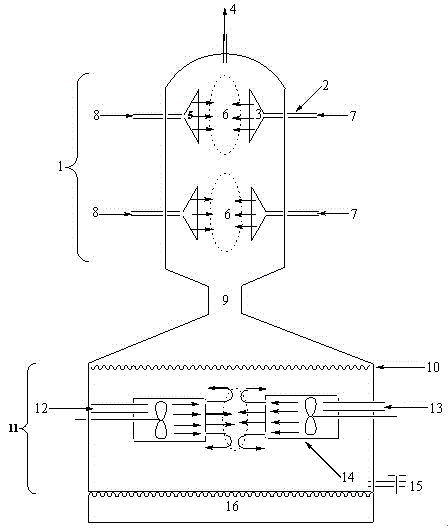Hydrogenation catalyst composition and preparation method thereof
A technology of hydrogenation catalyst and composition, which is applied in chemical instruments and methods, metal/metal oxide/metal hydroxide catalysts, physical/chemical process catalysts, etc., can solve the problems of active metal aggregation, inhomogeneous reaction environment, no Activity and other issues
- Summary
- Abstract
- Description
- Claims
- Application Information
AI Technical Summary
Problems solved by technology
Method used
Image
Examples
Embodiment 1
[0061] This example introduces the preparation method of Mo, Ni, P active metal salt solution. In this example, only one concentration and proportion of Mo, Ni, P active metal salt solutions are prepared, and solutions of other proportions and concentrations can be prepared according to the described method.
[0062] Take 386g of molybdenum oxide and 123g of basic nickel carbonate into a multi-necked flask, add a certain amount of deionized water, stir until the material in the bottle is in slurry shape, then slowly add 86g of phosphoric acid, and then slowly heat after the initial reaction. , keep the solution temperature at 90-110°C for 1-3 hours, stop heating, filter the obtained solution while hot, and then add phosphoric acid to adjust the pH of the solution to 1.0-4.0 to obtain a clear dark green original solution. The solution composition is MoO3: 69.27g / 100ml; NiO: 12.49g / 100ml.
[0063] Take 296g of ammonium molybdate and 105g of nickel nitrate into a multi-necked fl...
Embodiment 2
[0066] Add bottom water to the bottom of the impinging flow reactor, and heat it to 90°C; start the impinging flow reactor, and adjust the frequency of the ultrasonic generator to 20 kHz. Adjust the impact direction of the two accelerating tubes to strike horizontally, and start the accelerator to add AlCl with a concentration of 45g / 100mL. 3 The solution was injected from the feed port I at a flow rate of 15L / h, and the liquid was atomized through the pressure atomizing nozzle and the acceleration pipe at the level of the feed port II was sprayed through the pressure atomizing nozzle. The concentration injected at the flow rate of 20L / h 40g / 100mL of NaAlO 2 The solutions collided with each other, reacted for 30min, and stopped injecting the liquid and the bottom ultrasonic generator; at the same time, the feed ports III and IV at both ends of the liquid-liquid reactor II were simultaneously added with NaAlO at 15L / h. 2 (concentration is 20g / 100ml), Na 2 SiO 3 (concentratio...
Embodiment 3
[0068] Add bottom water to the bottom of the impinging flow reactor and heat it to 90°C; start the impinging flow reactor and adjust the frequency of the ultrasonic generator to 30 kHz. Adjust the impact direction of the two accelerating tubes to strike horizontally, and start the accelerator to add AlCl with a concentration of 50g / 100mL. 3 The solution is injected from the feed port I at a flow rate of 25L / h, and the liquid is atomized through the pressure atomizing nozzle and the acceleration pipe at the level of the feed port II is sprayed through the pressure atomizing nozzle. The concentration injected at the flow rate of 20L / h 48g / 100mL of NaAlO 2 The solutions collided with each other, reacted for 25min, and stopped injecting the liquid and the bottom stirrer; at the same time, NaAlO was continuously added at the feed ports III and IV at both ends of the bottom of the impacting flow reactor at 16L / h. 2 solution (35g / 100mL) and AlCl 3 Solution (concentration is 30g / 100...
PUM
 Login to View More
Login to View More Abstract
Description
Claims
Application Information
 Login to View More
Login to View More - R&D
- Intellectual Property
- Life Sciences
- Materials
- Tech Scout
- Unparalleled Data Quality
- Higher Quality Content
- 60% Fewer Hallucinations
Browse by: Latest US Patents, China's latest patents, Technical Efficacy Thesaurus, Application Domain, Technology Topic, Popular Technical Reports.
© 2025 PatSnap. All rights reserved.Legal|Privacy policy|Modern Slavery Act Transparency Statement|Sitemap|About US| Contact US: help@patsnap.com



